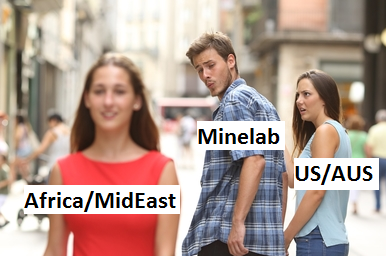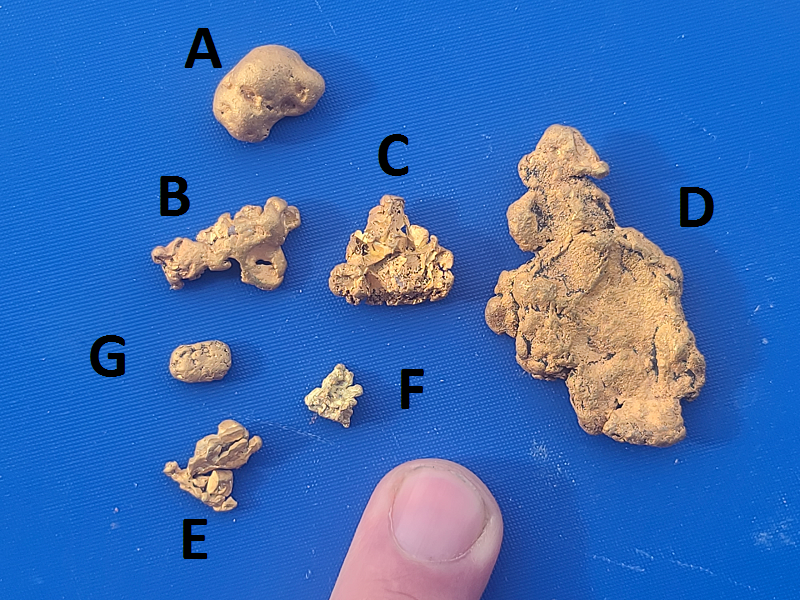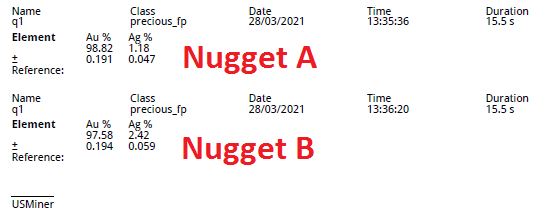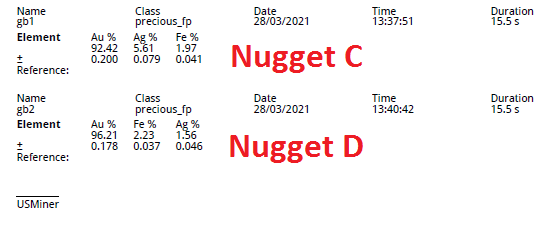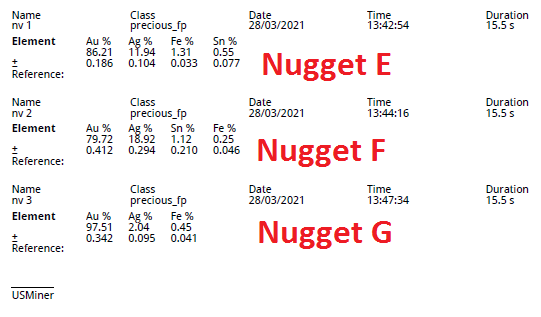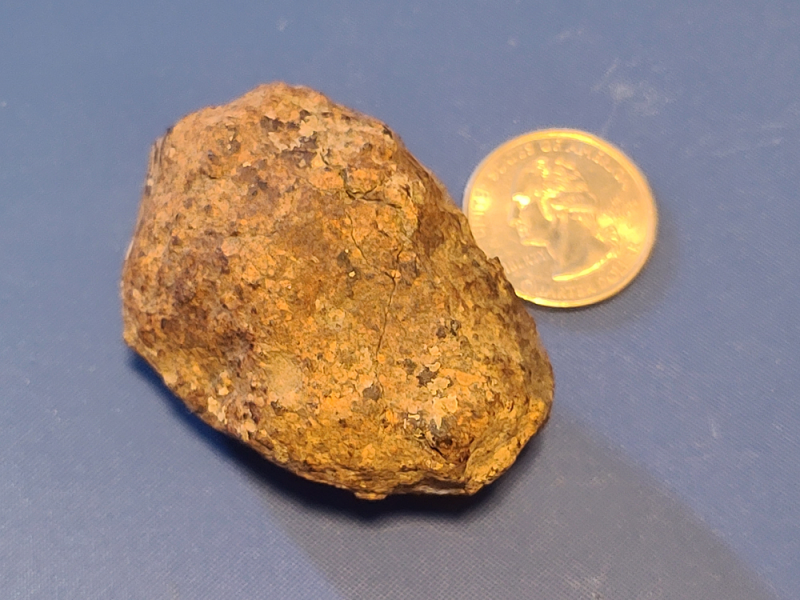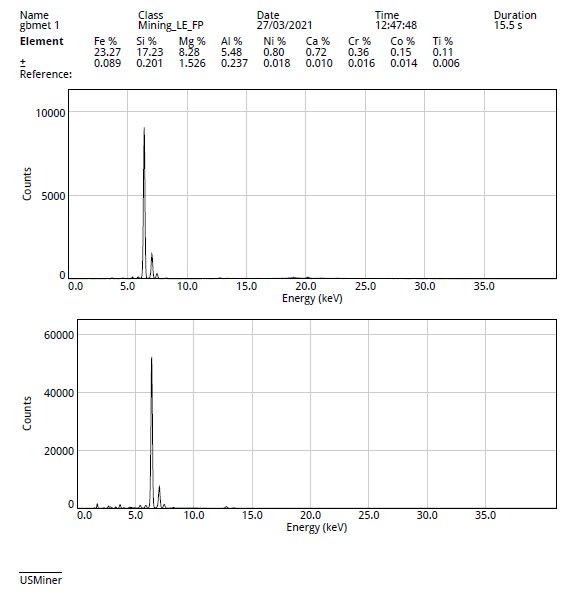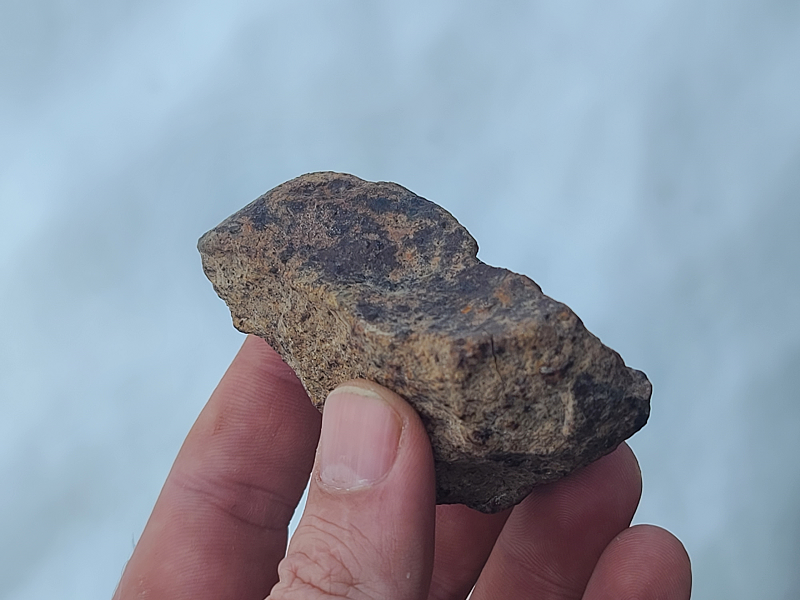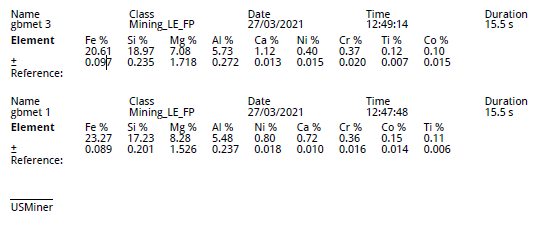-
Posts
2,468 -
Joined
-
Last visited
Content Type
Forums
Detector Prospector Home
Detector Database
Downloads
Everything posted by jasong
-

Official Minelab GPX 6000 Page
jasong replied to Steve Herschbach's topic in Detector Prospector Forum
It occurs to me that the lighter shaft on the 6000 is going to shave weight in a critical area towards the coil end too, and that might just make all the difference (especially when I'm comparing weights to the GPZ in my head and how different coil weights on it feel), so I shouldn't just be considering the coil weight alone since the 6000 is bringing better carbon fiber shaft design to the table. But you two supermen are outliers. Most average detectorists used/still use a bungee on the 4500 and 5000 on anything around the 11" (800ish grams) or larger for all day detects outside of patches. Including myself. -

Official Minelab GPX 6000 Page
jasong replied to Steve Herschbach's topic in Detector Prospector Forum
Thank you JP, thats the kind of stuff we've been missing. Are you allowed to talk about all field experience now freely or still limited? -
Biggest change is wireless headphones have built in amps. A big part of impedence issue is making sure the speaker is matched properly to the amplifier, which in the case of wireless units is done by engineers/designers and does not matter what device you attach it to. So, even though I'm not much of a headphone user, I think the most important thing with wireless phones would be selecting a product with both a well designed amplifier and a quality speaker element, and a company that cared enough to match the two. At least for products that have BT built in like a phone or a 6000. An external BT 1/8" transmitter itself for products without it built in might have the potential to introduce balancing issues though? The cheapo units probably sound bad because the amplifier is insufficient at higher volumes, or is over driving whatever cheap speaker element they use. I agree with what Tboykin said too. Pure tones are not really going to benefit from higher impedences in the same way as a complex audio signal with a wide range of frequencies like music will.
-

Official Minelab GPX 6000 Page
jasong replied to Steve Herschbach's topic in Detector Prospector Forum
Think it's with coil covers. But even just ballparking weight comparisons, the 14"DD (and to a degree the 17" mono) appear to make the machine as heavy as a 5000, a machine which notably is not considered a "light" machine and hence my confusion about why the 6000 is considered light or doesn't need a bungee. I never met anyone in the field who was swinging the 5000 without a bungee, other than patch cleaning where one stayed in the same place and set the machine down often, or using stuff like Sadie's. So I'm not understanding why everyone seems to think it's now lightweight to swing the same weight on the 6000 with the 14DD? This type of question can be subjective though, maybe ergonomics are that much better, and is best answered by actual use in field reports by experienced detectorists who've also spent a lot of time swinging a GPZ and 5000 in order to have a reference frame to report upon. For those who simply want/need a smaller coil in the 11" mono, or those who don't already own a GPZ I can see the point of purchasing without knowing these things I listed earlier. But for me, I need to know before dropping 6k, and since I don't care about the 11" mono (I already own smaller GPZ coils), I remain unconvinced the claims of lighter weight have any relevance to me. But performance wise, I'd be stupid to ignore anything that gives me power I can put to use profitably that I don't currently have, so I am still paying attention to the 6000 even if I'm not in the pre-order gang, hence my frustration that ML won't seem to allow any real field reporting from actual prospectors who's opinions I would value. -

Official Minelab GPX 6000 Page
jasong replied to Steve Herschbach's topic in Detector Prospector Forum
Well seeing as right now the three main claims of benefit - lighter weight, sensitivity to smaller gold, and improved performance in salt - are all completely without field test data to give meaning to the claims, those would be good starts. How the 14" DD performs in salt and some actual data showing how it outperforms the GPZ and when/if it stops at a certain size nugget even in salt would be 1st on my list personally. The 14" DD weighs 1015 grams which makes swinging it heavier than a 5000 with the 11" coil (820 grams) and not a ton lighter than the 15x12 Commander (1120 g). So, an actual field report from someone that has swung this DD coil for many days, all day or even weeks all day would be good. The 5000 required a bungee for many, so will the 6000 too if you use the DD? An 11" mono is too small for general exploration/prospecting, so if the 14" feels about like swinging a GPZ and requires a bungee still, then how/where exactly it outperforms the GPZ is crucial info (again why #1 and #3 are important in conjunction). I know I can swing a 1000 gram coil without a bungee, but I choose not to if I'm doing it all day every day, and I can't see how a lighter control box make this newly possible now but I could be wrong. Lastly would be showing which weights nuggets it outperforms the GPZ on in normal ground, and where the crossover point is at. Not knowing those 3 things are specifically what stopped me from buying one. And what could change my mind. -

Official Minelab GPX 6000 Page
jasong replied to Steve Herschbach's topic in Detector Prospector Forum
A 7500 with GeoSense, lighter coils, better noise and ground filtering, and increased depth would certainly go over well here. Seems the natural progression of development to build on prior ZVT and 6000 work. And since our goldfields are so much more flogged, every iota of performance counts here and people are willing to pay for it whereas a 6000 probably does just as good as a 7000 (or 7500 for that matter) in Africa so why spend more? I am choosing to believe such a thing is in the works marketed towards US/AUS markets and that's why we are being passed over with the 6000 release. Yeah, total guess based on nothing, but why not. 🙂 -

Cleaning Gold Specimens - The Final Results
jasong replied to Glenn in CO's topic in Detector Prospector Forum
Thanks, I enjoyed that series of posts! -

Official Minelab GPX 6000 Page
jasong replied to Steve Herschbach's topic in Detector Prospector Forum
Minelab is basically just trying to create their own social media. That's what "detexperts" are, and that's why they are choosing their own no-name relic hunting channels to give exclusive looks into prospecting specific equipment in whatever controlled manner they find acceptable. These are people that will post whatever they want, in whatever manner they find acceptable. It's patronizing as hell IMO. Maybe if you are selling ACE 250's. But $6k to $10k detectors to serious enthusiasts and literal professionals doing this as full or part time business? Give me a break. It's the kind of stuff that would hurt a company who doesn't have a monopoly. Like Ferrari hiring Bob the station wagon owner to demo a new highly anticipated model by grinding the gears and stalling the engine, instead of letting Michael Schumaker show off what it can really do. The minute a prettier lady walks by, we don't matter. I think it's kinda a hilariously inept and tone deaf. Like this stupid meme which is about as poignant demonstration of things as their videos. -

GPX 6000 Introduction For Beginners Video
jasong replied to cobill's topic in Detector Prospector Forum
Me too, that's why I prefer to shoot for one 4 ouncer and not 1000 dinks. -

Official Minelab GPX 6000 Page
jasong replied to Steve Herschbach's topic in Detector Prospector Forum
Nope, I just want to test it where there is really no (specific) claims being made, and definitely no data. In salt and bad ground. I really don't care if it outperforms the Z on dinks. But if it's outperforming the Z on appreciably sized stuff in difficult ground types where the Z struggles with any size coil - well then it's a real useful tool IMO! -

Official Minelab GPX 6000 Page
jasong replied to Steve Herschbach's topic in Detector Prospector Forum
I love data and I don't care if people rain a sh-storm onto me: I'll test and compare the 6000 to the 7000 the first chance I get because I'm curious and want to know. Bring it on. If I find that in the wet salt it's hitting 2+ grammers at 2-3"+ deeper than the GPZ then I'll find some way to finance it and get one in my hands, because I can make that pay. This is a professional level machine marketed primarily to people doing this for a living. I can't believe that even in Africa there is just zero specific performance data. Nothing... Like, I can't think of a single other product that is marketed to professionals or full timers that utterly and completely lacks any kind of specific performance data or at least performance comparisons to existing products. The crappy videos are blah, but this part just utterly baffles me. Star charts are not quantitative performance data, it barely qualifies as qualitative...or data. It makes me wonder if there is a 7500 coming with plenty of cutting edge performance upgrades for squeezing juice from the dry lemons that are US (and increasingly AUS?) goldfields, and the 6000 was intended by ML just to fill a niche for people that don't really care about such things and just want something better than the 5000 that is quick and easy to use? -

GPX 6000 Introduction For Beginners Video
jasong replied to cobill's topic in Detector Prospector Forum
I duuuuuunno about that one Lunk. 108 grams of gold to pay the 6000 off in nuggets the GPZ misses? What are we talking, mostly dinkster 0.10 grams or under then? That's 1080 nuggets. Most prospectors I've met haven't found that many nuggets of all sizes combined in their whole lives. I only find maybe 150-300 (of all weights total) a year myself and I'm usually at the upper end or top of the scale compared to anyone I meet and talk with who isn't working heavy equipment. Realistically, there are only a small handful of people with exclusive access/location knowledge who will be making the 6000 pay for itself specifically in finds the GPZ missed. In the USA anyways. Unless the 6000 does some serious magic in the salt and other bad ground, which is the thing we still have zero quantitative information on, frustratingly. -
No current assays, soil sampling, drilling, or geologic mapping. Everything in their presentation is historic. They need to show some kind of results first. That Dutch Flats area produced some placer nuggets, but it's been claimed since before I started detecting for gold.
-

Official Minelab GPX 6000 Page
jasong replied to Steve Herschbach's topic in Detector Prospector Forum
If the DD performs really well in salt then a ton of Northern (and other parts) Nevada will be a renewed playground. Also, people in some renowned "hot ground" areas in AZ will discover to be true what I've been saying for years but cannot seem to convince anyone of: some of the gnarliest hot ground down there is actually just salty and not "hot". Sometimes a little of both. -

GPX 6000 Introduction For Beginners Video
jasong replied to cobill's topic in Detector Prospector Forum
With all the experienced gold detectorists out there, all the gold detecting channels 50k-100k subs, all the dealers who could be showing the unit off while knowing what they are talking about - they choose to give this opportunity to a no name relic hunting channel in Florida where 6000 will see zero usage? And let a guy who doesn't appear to have ever detected for gold nuggets a single day of his life, who will probably never use a 6000 and has likely never touched a 7000, and is looking at it like it's some kind of perplexing mystery stick give his opinion on wether it's an improvement over old tech or not? I mean, you could have gotten virtually the same thing by grabbing any random Joe off the street, his opinion means zero to me. Just...what? No words for the amateur hour this entire release has been. I'm honestly embarassed for them watching this kind of stuff. -

Cleaning Gold Specimens - Step By Step Methods
jasong replied to Glenn in CO's topic in Detector Prospector Forum
Golden fleece, literally. Nice stuff to see emerge. -

A Basic Intro To Xrf Guns For Prospecting
jasong replied to jasong's topic in Detector Prospector Forum
All good questions - that I don't know answers to. But I think you are right that any Pt in a nugget may kinda "blend" into the Au results if it's present. For testing it's sorta a chicken or the egg the problem - I can see if it'll ID Pt in Au if I had a Au/Pt alloyed nugget, but I can't find out if I have a Au/Pt alloyed nugget unless I ID it first. So, I'll probably start acquiring some odd samples over time which already have a certified assay or XRF or XRD results as I run across them for sale, just so I can use them as control measurements for my gun. It occurred to me last night before bed that to test the ability to detect Cu in gold alloys, I could just buy a ring, or actually I might already have some rings made of Black Hills Gold (high Cu) that I've metal detected over the years in some boxes. I presume the silver depletion is due to oxidation (or maybe reaction with environmental chlorine or acids from rains or leeched from chems in gravels/nearby ore?) and it's possible copper could undergo similar processes. But chemistry is my seriously weak point. I have no problem cutting into general nuggets, and I have a thin kerf diamond blade I could use for minimal waste. I just sold all the gold I had which I didn't specifically want to keep undamaged though, so I don't really want to cut into any nuggets I have right now since it's just a small handful of type specimens from each location which I'm going to eventually put in a display case. But I think I will do that next time I find a large-ish nugget 1/2 oz or so, big enough to take readings across from the center to the rim. See if I get a "tree ring effect" of increasing silver and maybe copper towards the center of it? When I get a big handful of nuggets again with different compositions I think it might be interesting to find like 5 with the same weight and geometry more or less, but different alloy compositions. See how different gold alloys affect detection depth since the conductivity of them generally decreases. -

A Basic Intro To Xrf Guns For Prospecting
jasong replied to jasong's topic in Detector Prospector Forum
Also, it seems that simply looking for increasing concentrations of silver in nuggets is the XRF equivalent of panning up a hill until you find the source. If you start finding a line where every nugget is increasing in silver concentration, then it may be a good bet that the source is or was at one time located somewhere up that line/direction. -

A Basic Intro To Xrf Guns For Prospecting
jasong replied to jasong's topic in Detector Prospector Forum
Ok, last one. This is on solid gold nuggets. Unfortunately, I tried every single calibration and when I zap a nugget the gold lines seem to overwhelm the copper. I have to assume some of these nuggets have a small percentage of copper in them at least? But it isn't showing up no matter what I do or try. I zapped a solid copper nugget and it read 100% copper, so it's detecting copper fine. So, if I want to look at solid nuggets, I probably need to have a calibration that can ID copper in high Au% matrix. Or alternatively, I suppose some of these might just not have trace copper? Anything I send to the refiner is always a ton of stuff melted together so I'm not exactly sure the assay composition of individual nuggets. Mining is limited to 75% gold concentration, so I went with precious metals package, also wanted to see if any platinum, palladium, etc were present, so any quartz (Si) will not show up here is about the only caveat. This is far less interesting to me since there aren't any real mysteries here to solve, but there are a few and some things to learn from it. But I did want to see if there were any hidden platinum group metals in any of these nuggets. A bit of rhodium or platinum here and there could add up quick! And I honestly have no idea if PGM's can be found alloyed in nuggets or not. Here are nuggets I tested: Sample A: 10 grams, Quartzsite slug & Sample B: 7 gram Quartzsite tangle w/small quartz grain inclusion Hmm, not much interesting happening in Quartzsite. Just some very pure gold with few inclusions. I've always suspected the nuggets here were high purity, and it's why I don't sell these ones in my 10% under spot bulk lots. A has more indication of travel than B does. The general theory is that nuggets enrich in gold at the surface with travel and weather, and you can see nugget A with more travel is exhibiting potential silver depletion at surface. Sample C, GB 7 grams with many angular pyrite casts & Sample D: GB 36 gram slug GB nuggets commonly have a black coating or inclusions that are resistant to acids. I have assumed they were manganese but a geologist looked under a microscope and told me he thought they might be cryptocrystalline versions of iron oxides, and that the crystalline structure of the oxide is preventing the acids from reacting vigorously. So, I can finally figure this mystery out. C has almost no indication of travel and many sharp, angular edges indicating pyrite or similar was once included but has weathered out. D is a large slug exhibiting signs of transport, and this piece is also older than sample C as it was found embedded into solid caliche about 6" deep in a layer of paleo gravels that I estimate are at least 800,000 to 1.5 million years older than the gravels which sample C was found within. So it seems the geologist was right! The black, acid resistant inclusions are in fact iron based, and not manganese based as I had assumed. Also, as with the Quartzsite nuggets, here in GB the nuggets displaying the most transport seem to be enriched in gold at the surface, and silver has decreased with weathering and transport. Sample E: octahedral crystalline NV nugget, Sample F: typical crystalline NV nugget, Sample G: NV paleoplacer nugget Sample E has several octahedral "grapes on a vine" (it's easier to see in person) and had distinct chevron patterns on the back. It was found on bedrock in a wash in Northern Nevada. It displays minor signs of transport. Sample F was found about 4ft downhill from a hardrock pocket of crystalline gold I discovered on a hillside and shows no signs of transport. Sample G was found very close to sample E on bedrock, but on an uplifted portion of bedrock and exhibits heavy levels of transport, and I am sure is a remnant from an uplifted paleoplacer even though the gravels have eroded away and left no evidence except occasional scattered quartzsite or granitic cobbles. All 3 nuggets came from within a 10 mile radius. There is an immediate correlation again, as with Q and GB nuggets, between gold enrichment on surface and evidence of transport. The inclusion of iron in these nuggets makes me wonder if the XRF is pulling over some copper results and interpreting them as iron. But I'm unsure with a control nugget with a known measurement to compare with. Looking at the results, I'm even more sure now that Nugget G, the hypothesized paleoplacer nugget, actually comes from a paleoplacer that has simply eroded away. Transport alone is likely not enough to account for the much higher concentration of gold in this nugget, and it's likely it came from another area altogether, especially since it appears to lack Sn (tin). Though, the inclusion of iron makes me think it might not have travelled as far as I thought (the Sierras or maybe Idaho), but instead might have a more localized source within a radius of 50 miles or so within NNV itself. Nuggets E and F both came from a decent distance apart, but the inclusion of Sn seems to indicate they came from the same mineralizing event. So - these results are enough to give me a good idea of exactly how to use this XRF for prospecting this specific area of NNV for gold though. I'll be zapping soil with an eye for Sn as a potential pathfinder. And looking at more nuggets along the way to try to find more correlations or clues, as well as analyzing the rocks themselves where I've found pockets and looking at what accessory elements are in them, and using those as soil pathfinder elements as well. And this is how I plan to personally use this XRF for gold prospecting this summer in NNV. Thanks for reading, congrats to anyone who made it through these walls of text. -
Because the GPZ takes forever to reboot and it's a ridiculous waste of time to turn it off and then reboot everytime you use the pinpointer in the hole. Pointers are tools meant to speed up the target recovery process, not slow it down. We have a pinpointer that doesn't interfere while off but barely works while on. And then every other pinpointer works good while on but interferes with the GPZ while off. That's the problem, and it's completely fixable.
-
If I'd have been thinking I would have bought the XP MI-6 pinpointer to test out. But I saw a new carrot for sale locally for a good price and grabbed it instinctively. But I am curious how that MI-6 performs both around the GPZ and with smaller nuggets. The biggest problem I have with the Garrett is it interferes when it's off on the GPZ, even from large distances like 4-6ft so there is no good place to keep it on my person. No amount of noise cancelling will fix that because it's not noise but inductive coupling to the pinpointer loop. Some don't seem to notice it or think I'm just blowing hot air, but I absolutely, positively guarantee that it happens. It bothers me so much that I literally sent my 2nd GPZ back to Minelab thinking it was broken at first (I was just running the stock coil back then too), which was embarassing when I found out it was working fine and simply hearing my pinpointer since I had never considered it would interfere when off. Seems like it'd be a real simple problem to fix, but I guess Garrett engineers probably don't read these prospecting forums. Minelab engineers do though, and I'm baffled why they don't fix the Pro Find 35 so that it works flawlessly with their flagship detector and fix it so it just works in general at sensitivities that compete with the Garrett. It could be a great pinpointer with what seems like fairly minor bug fixes. Maybe they will read this and do some fixin'? I'll be first in line to buy an improved Pro Find 45 if so because there does not appear to be any (decent) pinpointer on the market which will not interfere with the GPZ when it's off.
-

A Basic Intro To Xrf Guns For Prospecting
jasong replied to jasong's topic in Detector Prospector Forum
I believe Arsenic is the main tracer element in Gold Basin soils too. I think lead maybe too, but I'll have to test it next winter. We have a commercial scale exploration project going on there right now with a ton of assays and drilling but that stuff is mostly mum at the moment. But I definitely look forward to doing a bunch of soil sampling next winter on my own, like you are doing. I had the same thoughts as you - zap everything with the XRF and then just send in the ones with tracer elements for assay when I'm just trying to outline ore bodies at first. That's crazy on the fish. I hadn't thought about looking at them. Mercury over there or something? I'm kinda curious to see what trout have in them over here now, but being so far from the ocean I'm guessing they are fairly clean of chems? I'm mostly using my XRF in Wyoming to identify rock types that evade tradition ID means since those odd rock types can themselves be tracers to things I'm looking for, just like Arsenic to gold, but I'm not really looking for gold here. In AZ next winter I should get some good field time with gold prospecting on this unit. -

A Basic Intro To Xrf Guns For Prospecting
jasong replied to jasong's topic in Detector Prospector Forum
So I wasn't able to find a university or lab produced x ray spectra of a Gold Basin meteorite, I was hoping I could to use as a control measurement since it's possible my XRF could be miscalibrated or not in the best mode. So, I'll wing this one and take my best guesses based on the data, and anyone with such a report can correct me later. What I did find was a report stating the University of Arizona has classified the meteorite as an L4 Stone Olivine Hypersthene Chondrite containing Olivine, Pyroxene, Kamacite, and 0.09% weight Cobalt. So, my initial guess about olivine being a likely constituent mineral was correct. Why did I immediately guess that? Because olivine is a fundamental rock forming mineral on Earth (and thus, likely in other places too), probably the most common, and I knew it had a good bit of magnesium in it. Simply put, olivine is always one of my suspects when I'm trying to ID minerals that have high magnesium, especially in cases the rocks are very, very old. Olivine (from webmineral): Magnesium 25.37 % Iron 14.57 % Fe Silicon 18.32 % Si Oxygen 41.74 % O Also, my XRF reading matches fairly close with UA's cobalt measurement, indicating these are both Gold Basin's and not some other stray meteorites in the strewn field. What I'm seeing in various reports is that the iron content of these meteorites is somewhere around 24%, which also matches fairly closely to my readings, understanding that the iron various widely millimeter by millimeter in a chondrite. The iron and nickel come from what UA is calling Kamacite, which has a very low nickel to iron ratio, which also matches what my XRF readings have shown (keeping in mind we are also pulling in Iron from the Olivine) Kamacite (from webmineral): Iron 89.54 % Fe Nickel 10.46 % Ni The aluminum is still a mystery to me. Pegmatitic materials would be unlikely on a meteorite I think. I'm not very familiar with the Pyroxenes, so I checked Wikipedia and I see the first sentence: "Pyroxenes have the general formula XY(Si,Al)2O6" So there is our aluminum constituent. Reading further the last mystery of this meteorite is solved: "...Y represents ions of smaller size, such as chromium, aluminium, iron (III), magnesium, cobalt, manganese, scandium, titanium, vanadium or even iron (II)." Wiki says the mantle of the Earth is composed of olivines and pyroxenes, so I probably should have guessed this one along with olivine to begin with, but I'm learning. Remember the strangely appearing Cr and Ti? It would be reasonable to assume it's coming from the included pyroxene minerals. Lastly, looking at melting points for Olivine and Iron, it appears to me the most likely theory for the iron enrichment in the fusion crust is simply that Olivine is melting first and ablating or even vaporizing, then later at a higher temperature the Iron melts but the heat is not enough to vaporize it so it remains. Oddly, the silicon remains too from the olivine though while the magnesium appears to vaporize. I don't know why and I don't have a guess because I suspect it has to do with chemistry and I suck at actual real chemistry. So, I know this was a lot to take in, especially for people just casually reading this. But this is the sort of information that can be really useful when using an XRF. These are the ways you can solve various mysteries, or at least how I approach doing so, and I'm wrong a lot too. These same mysteries appear daily when I prospect for terrestrial minerals, and thinking about and then solving the questions that arise can lead to some understandings of an area of interest that literally no one else on the planet has except you. That is an advantage, and a part of prospecting is finding advantages and putting them to work and turning them into discoveries. If this is the type of stuff that is useful to you when prospecting, then an XRF may be a tool that is worth every penny. -

A Basic Intro To Xrf Guns For Prospecting
jasong replied to jasong's topic in Detector Prospector Forum
Since I don't have any gold ore here at home and there is 6ft+ of snow in the mountains here, I was trying to think of something sitting around the house with a fairly complex composition that would still have relevance to prospectors. So I decided to take a look at Gold Basin meteorites. I'm not a meteorite guy and honestly other than iron and nickel I was pretty unclear about what exactly a stony meteorite is made out of since I've never read into it so I thought this might be interesting. On a side note, I just realized another thing stolen out of my RV during the theft out there - a big tupperware storage box full of meteorites. Probably 10lbs+ worth, I had been tossing them in there for a few years. Luckily I have more at home, and some thief probably has no clue what he even stole. Oh well. So anyways, these meteorites I have here were mostly recent and dug deep as they were stuff I had missed with the Z14 but later hit with the various X Coils this season, and as such they do not have strong fusion crusts since they have weathered heavily being buried in the ground where moisture remains much longer than on surface. Sample 1, 110grams, not much fusion crust, small stress fracture I shot this one as close to the middle on this face you see in the photo here, off to the left side of the stress crack. I am running in Mining_LE_FP mode, which means "light element" and "fundamental parameter". Iron is not light, but what it's referring to is the matrix material (the meteorite itself) because this mode is actually calibrated to detect heavy elements too, and I'm unsure what the matrix is so I'm using LE mode to start since it's a common mining mode for general ores including those with iron. I am using a fundamental parameters mode because I want to see if it can calculate elements independent of the matrix. This does not require known samples to calibrate to, and clearly my XRF is not calibrated to a Gold Basin meteorite. I am just doing 15 second scans as we don't need extreme accuracy here, we're just spitballing the basics without many concerns for accuracy yet. (note: mining modes are generally in PPM, but I have changed it set to % since this is just an intro guide and % makes more "human" sense) Let's look at the results: Wow...ok. Not what I expected, but again I don't know much about meteorite composition. I really thought I'd be above 50% iron and maybe 15%+ nickel. And far less silicon. But, these are stony meteorites and not iron meteorites, so maybe these results do make sense. The graphs are showing the spectral results for each element in the meteorite. The top graph is from the 40kEV beam and the bottom graph is from the 15kEV beam. You can see that there isn't much in a GB meteorite that a 15kEV beam misses, other than a bit of info around 20kEV. I cannot figure out how to get the machine to export the element lines themselves with the graphs yet, or to zoom in around a specific energy, only on the viewscreen on the machine itself can I do those things. So, to save space I won't include the spectrums in the other meteorite results. Notice the results do not add up to 100%, as I explained would happen in the first post. This is because the XRF cannot detect elements lighter than magnesium, so the missing mass is locked up in rock building stuff like oxygen, hydrogen, carbon, etc. Let's shoot it again, this time using the general Mining Mode, which lets the machine automatically select the best calibration. This is the default mode, and what most people would use starting out. Ok hmm, what's changed here? Why does the meteorite no longer have silicon, aluminum, or magnesium in it? So first, this is a chrondrite. Which means it's very un-homogeneous from point to point. One measurement could hit a chondrite, while the next could be in all matrix material. This is why samples really need to be crushed/powdered, mixed, and then analyzed for accurate results. But look at the "Class". The XRF has automatically selected "mining_fp", notice the LE (light elements) is missing from that calibration? This is what I meant in the first post by the gun itself could be calibrated for all elements, but if the specific calibration (in this case, mining_fp) is not calibrated for those elements, they will not show up. This is why buying a gun with only "alloy" calibrations will require sending the gun to the manufacturer for significant new calibrations, and significant more $$'s. The subtleties are not often explained, and I wanted to show a good real life example of why people will buy a unit off ebay thinking they can use it for some specific application like gold prospecting, only to discover their unit needs another $8k in work at the manufacturer. Luckily my XRF has basically every calibration the factory offered, already installed. And this is why it took me 5 years of searching for one like this that was also affordable. Sample 2, 170 grams, some fusion crust remains I wanted to to see how the fusion crusted edge looked compared to the weathered away part of a meteorite. Like I mentioned earlier, most of these were dug deep where the soil stays moister, so the ones I have here mostly lack any kind of very strong crust, but this one definitely has it visible. I took a picture outside where it's snowy because the white balance on my phone seems to get thrown off and not show the crust very well inside. I tried centering the measurement on that good sized area of fusion crust above my thumb. Accuracy is not exactly easy to achieve though, but I'm sure I got it onto the crust. Here are the results: Hmm again, not what I expeted. Being the rim, I expected to see some iron depletion due to weathering. But we actually see a higher concentration of iron. Looking closer though, you can see that the crust appears to be largely iron and in some places it's turning into limonite or rust (brownish red spots o the top and right of my thumb). Oddly though, there is no magnesium in this reading even though I am in an "LE" configuration. Why? I don't know, but my guess is that iron melts and forms the majority of the crust while the other minerals in the meteorite, especially whichever one contains magnesium, ablates away as the stone melts and falls. So, this is one example where it's important to understand the calibration, but also to be able to interpret the results. The answer depends largely on wether I can interpret correctly or not (in this case, I honestly have no idea, just guessing). Also, in this case the relatively shallow sample depth of the XRF wasn't a hindrance as much as it helped us. Because all we wanted to look at was the thin veneer of fusion crust. So anyways, it appears that the fusion crust is enriched in iron, whatever the reasons may be. It is possible this could affect how detectable a meteorite is too, or what it sounds like on some metal detectors, but that's another guess. Sample 3 (sample 1 reshoot) I decided to reshoot sample 1 again except on a different spot, intentionally trying to avoid a chondrule and just into the matrix if I could. My main goal was to see what the elements with less concentration than aluminum look like and how they change. I am doing this because after I write this post I am going to see if I can find actual XRF spectra of GB meteorites (if any meteorite guys have a university or lab result, please share it) and then to see if I can identify what likely other mineral components make up a GB meteorite based on the results we see here. Ok, so the new reading is at the top and the old reading is at the bottom. It does seem like I got more matrix in this reading, but you can see how this particular meteorite also has a somewhat unique "fingerprint" (I hope to look more into that in a future post when I get some time to think about the results and do some internet sleuthing), and it also seems to have 3 unique trace elements - Cr, Co, and Ti - which might be able to be used to differentiate a GB meteorite from another identical looking chondrite. But I'm just guessing because I haven't looked at any other meteorites to see if those elements are also present or not. So, looking at contituent mineral ID's, here's my thoughts right now before I've done any googling - Fe and Ni are self explanatory, but I feel they are a bit low and maybe my XRF needs calibrated or a different method used instead of Mining_LE_FP. Si, Mg, Al, and Ca are very common rock building elements. Right away, being a physics trained guy and knowing how old meteorites are, my first thought is the Si and Mg is coming from fundamental, old, and very common rocks like olivine. The Ca could be a number of things but the small concentration leads me to guess terrestrial caliche remnants after falling to Earth (if accuracy were a concern I would have done the measurement on a fresh cut face). And the Aluminum is the big mystery to me since the minerals I can think of generally wouldn't be solar system-level old and are largely terrestrial, so that will require Googling. Also of note is that Iron and Nickel both decrease, showing they may be alloyed together somehow or physically together in some way and not dispersed through the stone homogeneously. Which again is likely due to this being a chondrite. So, while we don't technically prospect for meteorites - this ended up being a great example to show how to use the modes, what to look for, the importance of interpretation and some basic geologic/chemistry knowledge, and how you might use a tool like this to ID minerals or mineral constituents in ores. More later on figuring out whats inside these meteorites... And even though the XRF really doesn't have good calibrations for looking at solid gold nuggets, that will be the next thing I play around with. Maybe see if we can tell the difference between a Quartzsite and a Gold Basin nugget, even though the geology and gold itself of the areas can be similar looking. -

A Basic Intro To Xrf Guns For Prospecting
jasong replied to jasong's topic in Detector Prospector Forum
Thanks for all the comments everyone, I'm glad there is some interest in this! The LIBS are interesting units, they are starting to appear on Ebay now used too, but more expensive than XRF. I'm waiting for that tech to develop some more. I was looking at a trying to build LIBS type system at home for lighter stuff like lithium and beryllium a few years back. Specifically lithium because of the big electronic vehicle battery rush. But I think I found a way to detect it with optical spectroscopy that is cheaper so I haven't paid much attention lately. Yep, the measurement is only a small fraction of an inch deep. And the spot is quite small in area too. For ores it seems the best technique is powdering them in a crusher and pelletizing them to avoid the "nugget effect" in even smaller scale. One thing I am thinking about is simply grinding down rock with a diamond wheel on a battery powered angle grinder, and collecting the powder for analysis, instead of crushing. That's interesting you are getting very close to your assay results Gold Hound. I hope to compare some XRF measurements to actual assays next winter. I am looking forward to trying this out on some gold ores, but right now everything near me is under 6ft of snow and my project in Arizona is 16 hours drive away. This XRF I have uses a rhodium anode, for the reasons you mentioned, I wanted a bit of increased sensitivity to gold. However, I also am looking at prospecting for rhodium itself and associated things like iridium, so I'll have to see how this anode effects that. I would like to buy some rhodium and iridium ore in proper matrix to test on before I go out to the field, but the stuff on ebay all appears fake (and way too expensive).


